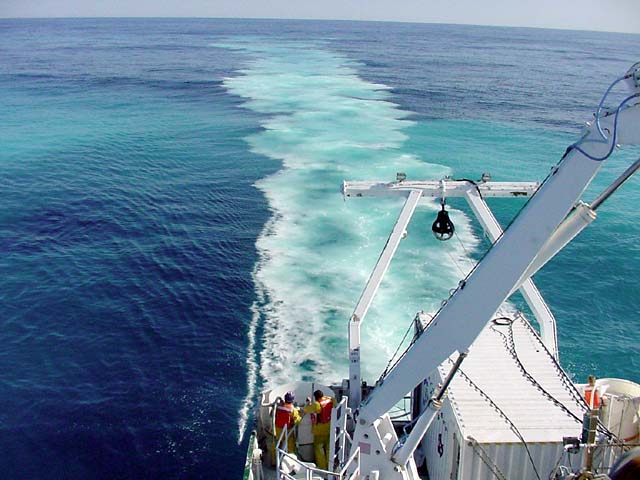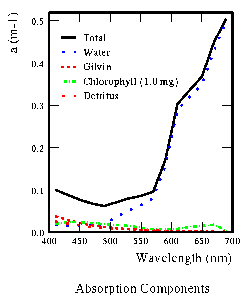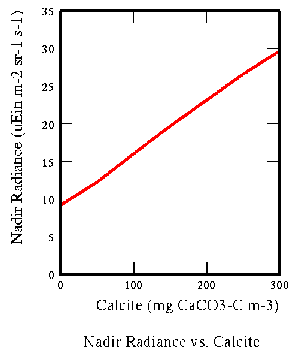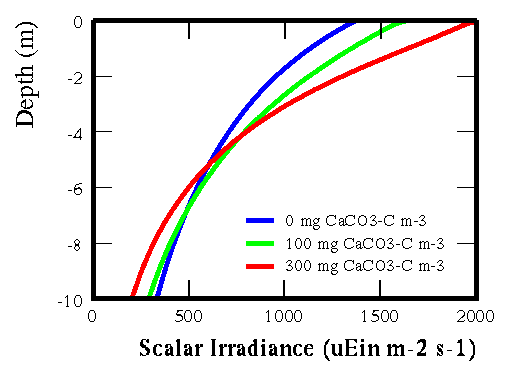Optical Impacts of Emiliania huxleyi
For most types of phytoplankton it is the chloroplasts (photosynthesising
parts of the cell) that make the most difference to the light, absorbing
photons and trapping them to form chemical energy for use by the cell. For
coccolithophore species though, the coccoliths as well as the chloroplasts
are optically important. The
coccoliths
do not absorb photons, terminating
their travel through the water, but rather they act like tiny mirrors,
reflecting or scattering the photons, causing deflections in their
directions of travel. This is why coccolithophore blooms change the
brightness of the water, and why blooms can be seen from the
space shuttle
and from
satellites.
The brightening effect of mass-release of coccoliths was also strikingly
apparent following an artificial experiment (called "Chalk-Ex") in which
chalk rocks (fossilised coccoliths!) were ground up before being added to
the surface ocean, as shown in the picture below.

In the Chalk-Ex experiment a 2 km2 patch of the Gulf of Maine had 13 tons
of powdered chalk added to it, in November 2001. Note the pale colour of the
water either side of the ship's wake. The powdered chalk was obtained by
grinding up Cretaceous-age rocks made of coccolith chalk, shipped especially
from the UK. The mean particle size was about 2 microns, the same size as
Ehux coccoliths! By comparison typical natural Ehux blooms in the Gulf of
Maine consist of hundreds of thousands of tons of chalk, spread over a
larger area (Picture courtesy of Barney Balch).
Although each coccolith is invisibly small, when they are present in
enormous numbers in the water they cause large changes in the way that
light is transmitted or reflected by the water. Figures 1 and 2 below show
the affect that different components in the water have on the inherent
optical properties of the water, i.e. on the probabilities of absorption
(termination) and of scattering (reflection) of photons. It can be seen
that an intense bloom of Ehux (100 mg CaCO3-C m-3) causes a large
increase in the scattering at all wavelengths of light (400-700nm) relevant
to phytoplankton, but no change to the absorption [Balch et al, 1991; Balch
et al, 1997a; Balch et al, 1997b]. 400-700nm is also the human-visible part
of the spectrum, with red light at ~650nm, green light at ~550nm, and blue
light at ~450nm.


Components contributing to absorption and scattering, in typical
proportions for mid-summer at 60N in the Atlantic, during a bloom of
Ehux. The effects of individual components are summed to obtain
total absorption and scattering. Effects of chlorophyll and calcite are
proportional to the amounts of the substances in the water.
The figure above shows the impact of coccoliths on the scattering at each
wavelength, but what difference does this make to the overall behaviour of
light in a coccolith-filled ocean? A Monte-Carlo optical model has been
developed to obtain answers to these questions, with the following results:
Firstly, the increased scattering causes the ocean to become more
reflective, i.e. the ocean's albedo increases. A greater proportion
of the photons which pass through the water-surface from air to water
subsequently leave again, from water to air, after having been scattered by
coccolith particles in the water. For a typical ocean, the proportion of
photons re-emitted by the water increases from 1% when there are no
coccoliths in the water, to 3% with 100 mg CaCO3-C m-3 of coccoliths in the
water, to 7% with 300 mg CaCO3-C m-3 of coccoliths.
The "nadir radiance" is the intensity of light travelling vertically upwards
just above the ocean surface. It is this signal that is picked up by
satellites, after transmission upwards through the atmosphere. The figure
below shows how the nadir radiance changes with increasing coccolith
concentration. From this diagram it is easy to understand why Ehux
blooms are so easily visible in satellite images.

Nadir radiance, Lu (uEin m-2 sr-1 s-1) as a function of coccolith calcite
concentration, for water containing 0.75 mg chl-a m-3, and with the sun at
45 degrees from the vertical. Model parameters are otherwise typical for
the NE Atlantic at 60N, during mid-summer.
Secondly, the addition of coccoliths to the water makes that water
brighter near to the surface and darker deeper down. Scalar irradiance is a
measure of total light intensity (photons are counted equally regardless of
the direction they are travelling in), and the figure below shows how this
changes with depth as coccolith concentration increases. The coccoliths
shade the deeper water, reducing the amount of light available there. This
reduces the depth of water which is habitable for the phytoplankton, because
they require a minimum light intensity to survive.

Scalar irradiance depth profiles for three different calcite
concentrations, with the same model parameters as for the diagram above.
The coccolith impacts can also be seen more graphically in this
model-derived comparison of water colour/brightness for no coccoliths and
for 300 mg CaCO3-C m-3 of coccoliths. These model results help us to
understand the
"white waters"
of coccolith blooms, alternatively described as the
fairy glow
coming from these bloom waters.


Model estimated water colour: comparison of 0 (left) and 300 mg
CaCO3-C m-3 (right). Parameters for the model were as for the two diagrams
above. The top of each column corresponds to the water surface, the bottom
to a depth of 10 metres.
paper
describing the optical impacts in detail
References
Ehux
home page
Toby Tyrrell : T.Tyrrell@noc.soton.ac.uk






